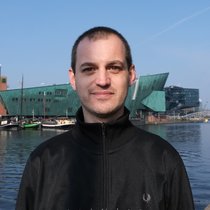In the battle against climate change, food waste has long been recognized as a problem, but not as a potential solution. If not managed correctly, uncontrolled food waste decomposition can lead to methane emissions, a greenhouse gas 25 times stronger than CO₂. Therefore, Yannick Schrik, PhD researcher for Wageningen University on 'Optimizing urban food waste valorization for biobased economy', asks a provocative question: What if the stuff we scrape off our plates could power our future bio-based economy?
Besides his PhD work, Yannick is involved in the Horizon project BIN2BEAN and the Project Proefopstelling met Voedselrestenvermalers (PVV, or ‘Kitchen Sink Grinder Lab’). Both projects focus on developing new valorization strategies for urban food waste. "Food waste is not just waste," Schrik says. "It's a container of valuable elements. The challenge is to recover them in the best possible way.
In Europe, cities must source separate and valorize 65% of recyclables by 2035, including food waste. Traditional collection in apartments and both old and new construction high-rises yields poor quantity and quality due to underground bin hassles and citizen anonymity. Kitchen sink grinders are envisioned to ease separation and collection, increasing the quantity and quality of the collected food waste.”
“Food waste is not just waste. It's a container of valuable elements.”
Yannick Schrik
Research fellow, PhD student, Living Lab manager
Shift to waste valorization
Under the European Green Deal, cities must help citizens separate food waste more effectively. However, in dense cities like Amsterdam, traditional collection methods—bins, trucks, and centralized sorting—hit logistical walls in high-rise buildings and narrow streets.
Enter food waste grinders. Common in American homes since the 1950s, these devices are banned in the Netherlands because wastewater treatment plants can't handle the extra organic load. European rules also mandate sewage sludge incineration to prevent agricultural contamination from pharmaceuticals and heavy metals.
But Schrik is flipping the model. Instead of sending food waste down the drain, he is developing a parallel plumbing system for high-rise buildings that deviates ground waste to decentralized collection tanks from sewage. It's food waste valorization reimagined, with infrastructure designed for value retention from the start.
"The terminology shift from waste management to waste valorization matters because it reflects the conceptual shift from seeing food waste as a disposal problem to seeing it as a resource optimization opportunity," Schrik explains.
Food waste as feedstock
Inside AMS Institute's experimental lab, a miniaturized high-rise plumbing system simulates kitchen sink grinder-based collection. The goal is to understand what happens to food compounds—nutrients, carbon, and minerals—once they're ground up, pumped, and processed.
High-quality, uncontaminated food streams open doors to innovative applications: microbial proteins that mimic meat and cheese, bioplastics replacing fossil-based materials, and soil improvers for agriculture. "Success for me is to develop context-specific combinations of separation, collection, and processing options, tailored to the needs and wants of a city. To match food waste with the best valorization strategy," Schrik says.
By Vincent Basler
The Bin2Bean project develops universally applicable methods to valorize food waste as a soil improver in urban areas. Cities across Europe are actively engaged in this mission, each contributing unique approaches—Amsterdam outsources to commercial entities, Hamburg leverages municipal companies, and Egaleo pioneers community-driven infrastructure. Beyond our core partners, municipalities worldwide are closely following our progress, recognizing the global potential of locally adapted solutions.
Currently, the strategic challenge is simple: anaerobic digestion for energy-needy regions, composting for mineral-deficient areas. But future decisions will be more complex. Do you produce bio-based platform chemicals or single-cell protein? "What's interesting about food waste is that it has a negative financial value but is potentially a huge burden to society," Schrik notes. "By transitioning from management to valorization point of view, we can try to minimize the costs and maximize societal benefits."
“Municipalities worldwide are closely following our progress, recognizing the global potential of locally adapted solutions.”
Yannick Schrik
Research fellow, PhD student, Living Lab manager
The cost of circularity
As cities worldwide aim to cut emissions and embrace circularity, they're running headfirst into an inconvenient truth: greener doesn't always mean cheaper. While the environmental case for valorizing food waste is strong, the financial roadmap remains unclear. Who pays for the infrastructure? Who profits from the outputs? And can policy keep up with innovation?
These unanswered questions keep food waste stuck in a holding pattern, bursting with potential but locked away from practical application. Researchers like Yannick and his colleagues are breaking down these barriers, transforming waste streams into valuable resources and turning circular economy theory into profitable practice.
by Vincent Basler

